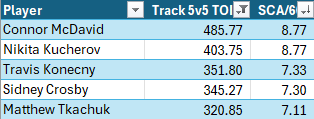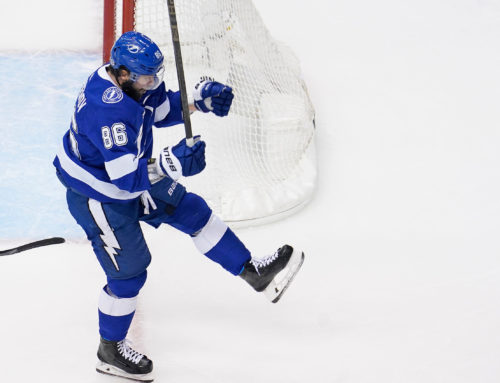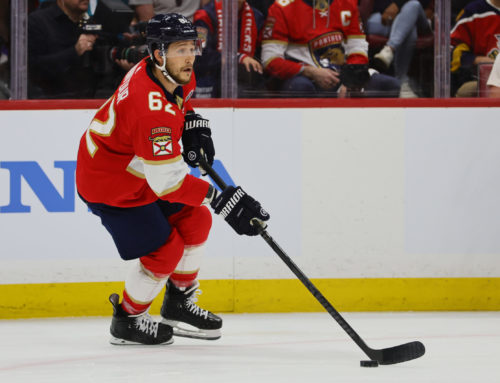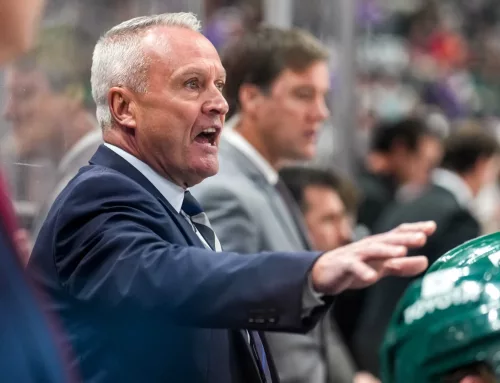Ramblings: Keefe in New Jersey; Evaluating Philadelphia’s Fantasy Season, Including Konecny, Tippett, Couturier, York, Ersson, and More – May 23
Michael Clifford
2024-05-23
Los Angeles removed the interim tag from head coach Jim Hiller and he'll be the full-time coach heading into the 2024-25 season. After taking over at the All-Star break, the team went 21-12-1 to secure their playoff spot. They were bounced in the first round by Edmonton, but they were a legitimately great defensive team down the stretch. How much he'll help their top producers be fantasy stars very much remains to be seen.
*
Sheldon Keefe was hired to be New Jersey’s coach, signing a four-year contract. I will have more on this in my Ramblings tomorrow because I think it’s an interesting hire and I want to take a bit of time to gather my thoughts.
*
Blake Wheeler was an extra at morning skate for New York and was not in the lineup for Game 1, but it seems eminently possible he'll get a game in at some point in this series. It will be interesting to see where they slot him if (when) they do put him in the starting lineup.
A goal from Matthew Tkachuk in the first period wound up being the game-winner in Game 1 between Florida and New York. A turnover from Artemi Panarin resulted in the Panthers going the other way and a soft Tkachuk shot eluded Igor Shesterkin for the 1-0 lead. An own-goal from Alexis Lafreniere made it 2-0 late in the third period and then an empty-net tally from Sam Bennett pushed it to 3-0 and the 1-0 series lead.
Carter Verhaeghe got credit for the own goal, and added an assist on the Tkachuk goal, as he totaled five shots and a hit in the win. Tkachuk also had a goal and an assist, managing two blocks and three hits to go along with it. Bennett had that empty-netter, five shots, two PIMs, and four hits.
Sergei Bobrovsky stopped all 23 shots faced for the shutout.
Florida dominated the first two periods and a good chunk of the third before there was any pushback from New York. The Panthers were able to completely disrupt anything the Rangers were trying to do in the offensive zone and were repeatedly stymying their puck flow. New York didn't look good, but a lot of credit has to go to Florida's game plan, too.
Game 2 is Friday night back at MSG.
*
We are down to the final five teams of my offseason reviews of the 16 non-playoff squads. Today's team is a team in transition in the Philadelphia Flyers. We have already gone over the San Jose Sharks, the Chicago Blackhawks, the Anaheim Ducks, the Columbus Blue Jackets, the Montreal Canadiens, the Arizona Coyotes (now in Utah), the Ottawa Senators, the Seattle Kraken, the Calgary Flames, the New Jersey Devils, and the Buffalo Sabres. Let's go over what went wrong for Philadelphia, what went right, and where they go from here, with all this put through a fantasy hockey lens.
Data from Natural Stat Trick, Evolving Hockey, HockeyViz, and Frozen Tools with salary cap data from Cap Friendly. Any tracking data is from AllThreeZones unless otherwise noted.
What Went Wrong
As with almost every team, this starts and ends with goaltending. The Flyers lost goalie Carter Hart due to his sexual assault arrest and his last appearance came on January 20th. After that point, young netminder Samuel Ersson took over, and it was a very unsteady road.
Ersson fared well earlier in the season when he was serving as the backup goalie. His first 20 appearances led to 12 wins, a .911 save percentage, and a 2.26 goals against average. Per Evolving Hockey, Ersson managed. 8.5 goals saved above average in nearly 1200 minutes up until January 19th (the next day was Hart's last appearance). On a 60-minute basis, he wasn't among the elite at the time, but he was among the next tier down:

The young netminder was doing very well as a backup, but we have to give credit to the Philadelphia defence, too. On January 19th, the team was top-10 in the league by expected goals against per 60 minutes at 5-on-5 and was giving up fewer high-danger shot attempts than teams like Winnipeg and Vegas. That also extended to the penalty kill where Philadelphia was giving up the second-fewest shots against per 60 minutes (only Carolina was lower). While Ersson does deserve credit for how he played in the first half of the season, playing behind a very good defensive team in all phases helps goalies a lot, too.
That all changed in the second half, and it's hard to pin it on the team. From the All-Star break onward, the Flyers were again top-10 by expected goals against and high-danger attempts against per 60 minutes at 5-on-5. The penalty killing numbers fell off, but they were still in the top-half of the league by shots against per 60 minutes and ahead of teams like Seattle and Los Angeles. The difference was Ersson went from 0.42 goals saved above expected per 60 minutes to -0.2. That is a change in excess of 0.62 every 60 minutes, or three expected goals every five starts, and speaks to how his play fell off as the season wore on – Ersson's final 30 appearances led to 11 wins, an .875 save percentage, and a 3.23 goals against average. Though his Goals Saved Above Expected per 60 dropped by 0.62, he added nearly one full goal to his GAA, and that was cataclysmic both for his fantasy value and, eventually, the team's playoff chances.
The other problem for the team, which spread the fantasy value issue to several players, was the power play. Philadelphia finished the season dead last by goals per 60 minutes on the power play, and it was a distant last as they scored 16% less often than the next-worst team (Columbus). Overall, they finished tied for total power play goals scored because they were able to draw power plays at a reasonable rate, they just couldn't do much with them. In fact, Evolving Hockey has them with the worst power play shooting percentage in a single 82-game season for any team since the 2013 lockout. Considering the team with the next-worst shooting percentage in a season over that timeframe is the 2021-22 edition of the Flyers, it's safe to say this issue permeates the franchise.
When looking at where the team was shooting from on the power play, the issue of getting any shots from the middle of the ice becomes clear (purple is bad because that's where they generate less than the league average):

Generating from the circles is fine, but there needs to be a slot/net-front threat or teams can just force everything to the perimeter (we went over this same problem in Tuesday's Ramblings with Buffalo's power play). That is what happened, and it hurt the fantasy values of a lot of key players.
That is why Cam York's 30-point performance is disappointing. He earned nearly 172 minutes of power play time and put up six power play points. His 2.1 points per 60 minutes on the man advantage was 45th out of 46 defencemen with at least 125 minutes of PP time (only Kris Letang was worse). Double that rate would have been about the average of those blue liners, and pushed York past 35 points. He may have even cracked 40 points had things been just above average, but they weren't so he didn't. He did have 174 blocks, 76 hits, 134 shots, and 44 penalty minutes, though, so he wasn't bad in multi-cat formats, it just could have been so much better if the team's power play could find any success.
It was both a good and bad year for Sean Couturier. That he returned from his serious back injuries at all is great for him, and that he played 74 games (his highest total since 2018-19) is also great. He did put up just 38 points, though, his lowest total in any season he's played 70 games since 2014-15. The 11 goals he scored was also the lowest total for him in any season where he's played at least 70 games, and we can thank his 5.7% shooting for that.
There was also the issue with John Tortorella. Couturier was a healthy scratch at times after the All-Star break and that is never good for fantasy value. He also averaged 19:57 per game until the All-Star break, and 14:19 per game after the All-Star break. Even when he was in the lineup, the team captain was relegated to third-line duties, and that led to seven points (and just one goal) after the break. In fact, Couturier scored just one goal over his final 37 games of the season, or his entire second half.
When looking at why that happened, one thing stood out: a lack of carried zone entries. The league average percentage for zone entries that were carried in at 5-on-5 was 52.1%. For just the Philadelphia forwards, it was 51.1%. The team had four forwards manage a carry-in rate under that 51.1% average:

The important part of those four names is that Travis Konecny and Tyson Foerster were Couturier's two most-common line mates. With Couturier and Konecny on the ice, the team scored 2.8 goals per 60 minutes at 5-on-5, about the same rate as when Couturier was on the ice without Konecny. It is a bit above the league average, but nowhere near what we would want from a player to be a coveted fantasy option. Add that to the poor power play numbers, and we get the season Couturier had.
It was a poor offensive performance from Cam Atkinson. He was also returning from a missed season due to injury but had just 13 goals and 29 points in 70 games. It was easily the worst fantasy season for him since becoming a full-time player in 2013-14. He did shoot just 7.4%, but his four-year average sits at 9.1%. He turns 35 years old next month, too. If the power play can get going, maybe Atkinson can be a 20-goal, 45-point player next season, but it does seem as if his 30-goal seasons are a thing of the past. Father Time comes for us all.
What Went Right
The frustrating thing about Philadelphia's season from a fantasy perspective, outside of the goaltending in the second half, is the power play. So much else went right that even an average power play performance would have made a huge difference for so many top performers.
Konecny finished with a career-high of 33 goals and 68 points, as well as a career-high 244 shots. He also had 90 hits and 67 penalty minutes, so there was great across-the-board value regardless. The issue was that he had just nine power play points, and actually had more short-handed goals (6) than he did power play goals (4). He could have easily been a point-per-game player had the power play not been absolutely terrible, which is where the frustration sets in.
On top of the goal scoring, Konecny has turned into a solid playmaker. Tracking data has his scoring chance assist rate at 5-on-5 in the next tier down from the elite performers like Connor McDavid and Nikita Kucherov:

Among forwards with at least 900 total minutes at 5-on-5, his primary assist rate was easily a top-line rate, and among some notable players:

With back-to-back seasons of at least 30 goals and 30 assists, the floor is set for Konecny. The team needs a better power play for all their top fantasy options to ascend to the next level, but Konecny, in particular, could be a top-25 multi-cat fantasy skater if that PP does improve. We are talking 40 goals and 85 points with very good peripherals-type territory.
Owen Tippett also had a good season to follow up his breakout 2022-23 effort. Tippett's 28 goals exceeded his total from the year prior, he surpassed the 50-point mark for the first time and had career-best marks in shots (289) and hits (148). He is also turning into a decent playmaker and, like Konecny, is a 40-goal threat if the power play ever right itself. Again like Konecny, Tippett did a lot of his work off the rush as his rush contributions at 5-on-5 (shots off the rush plus assists on teammate shots) was in the next tier down in the league and among some very productive wingers:

There was a reduction of ice time, and that's a concern, especially on a Tortorella-coached team where any player can drop from 19 minutes to 14 minutes depending on his mood. However, if he can add 10 power play points and get a bit more ice time, it's not hard to see Tippett putting up a 35-goal, 70-point season. Add that to great peripherals, and there's a budding multi-cat fantasy star here.
Joel Farabee had a solid season with a career-high 22 goals and 50 points, cracking the 40-point mark for the first time. He did a lot of the damage at 5-on-5 as his points/60 at that strength was 2.25, just behind Tippett and Konecny, and tied with Matt Boldy in Minnesota. However, he also had a three-year low in ice time and was sixth among their forwards in percentage of power play time earned:

We will have to see what the team does this summer but there are young guys like Foerster, Morgan Frost, and Bobby Brink already on the team, Matvei Michkov on his way in a couple years, and proven players like Konecny and Tippett. Farabee just turned 24 years old in February, so he's firmly in his prime and, like the others, a good power play would do wonders for his fantasy value. It is a matter of whether he's in a position to earn those power play minutes, and for how many years, given all the young forward talent there now (and on the way, in Michkov's case).
It was a good year for Travis Sanheim. He reached 10 goals for the first time, surpassed 40 points for the first time (44), had a career-high in shots (146), penalty minutes (48), blocks (149), and hits (94). He also had just five power play points. With York earning PP ice time and Egor Zamula looking like a good puck-moving defenceman in his own right, it's a wonder if Sanheim ever earns meaningful power play minutes again in this Flyers era. He just proved he doesn't need it for good across-the-board value, though, and with the team hopefully improving offensively as the forwards mature, Sanheim should be a 40-point threat with solid peripherals moving forward.
Where They Go From Here
This is a fascinating time for the Flyers. Had it not been for Ersson's second-half collapse, they probably would have made the postseason. Sometimes, that can put pressure on a young team (see: Buffalo Sabres) and forces the hand of management to make changes. The change won't be behind the bench (yet) so it's a matter of what happens with the roster.
It is clear that this team won't really take off until Michkov gets there. Though things can change, he isn't expected to make his way over from Russia until the 2026-27 season. That is two more seasons, and it's a wonder if the management group will wait that long to make any significant changes to the roster. Given their trade for Jamie Drysdale, they don't see shy of making impact deals, so it makes this summer an interesting offseason for them.
This team is loaded on the wings. They have Konecny and Tippett up top, they have Foerster and Brink developing well, and they have Farabee who can play anywhere. They also have both Ivan Fedotov and Ersson in net so while they might sign veteran depth (like Toronto did with Martin Jones), it's unlikely the wing or the crease are areas where they look to improve.
There is also the issue of cap space. Even with Hart's cap hit removed and Ryan Ellis on injured reserve, they'll have under $10M in space for the offseason. They also have to re-sign Zamula, and either sign defensive depth to replace Marc Staal and Erik Johnson or promote from within. Maybe they give Emil Andrae some run, or make top prospect Oliver Bonk a regular. However, even with a low-dollar Zamula bridge contract (say, $2M a season for two years) and a cheap UFA addition on the blue line (say $1M), they'll have under $5M left in cap space. They don't have the room to make any big additions without moving anyone out.
One thing they do have is draft capital. They have two first-round picks and two second-round picks in each of the next two seasons. They could move out a low-dollar contract like Scott Laughton or Garnet Hathaway (or shed Cal Petersen's deal), add a couple first- or second-round picks, and go get an impact forward (almost certainly a centre). Not saying that is what they'll do, but their ample draft capital and bevy of young players gives them options to improve the roster in a big way.
There is also the question of what to do with Couturier. He has six years left on his deal at $7.75M per season. If he ends up a bottom-6 player for them, how long do they hang onto that cap hit? It is a question more applicable after the 2024-25 season when they free up money elsewhere from the expiration of the contracts of Ryan Johansen and Cam Atkinson.
Konecny is also a year away from UFA status. He is the clear top forward on the team right now but he'll be expensive and how that aligns with their future remains to be seen. He likely stays, but nothing is certain until pen is put to paper.
Unless the team makes a big picks-for-player trade, it seems largely standing pat is what's going to happen. They'll wait another season for more aging contracts to run out, see if Couturier can rebound, and find out what they have in guys like Foerster, Frost, Brink, Zamula, Fedotov, and Ersson. Give them another year to show what they can do, and then reevaluate next offseason while adding some depth this offseason.
For fantasy players, that wouldn't be particularly appealing. Unless they give Zamula regular run on the top PP unit, there are serious questions on whether they can turn the power play around. It's unlikely they repeat the lowest shooting percentage in a decade, but just a marginal improvement isn't enough for their top fantasy options to reach their highest potential. Maybe we get a 70-point season from Konecny, and a 60-point season from Tippett, but until that power play really becomes dangerous, it's hard to say much will improve if they run back largely the same roster with the same coach. There will still be players worth drafting, they just won't have the upside they should, and that's frustrating. It is an exciting time to be a Flyers fan because this is a team on the rise, but fantasy value does not always equal real-life value.





 BUF
BUF N.J
N.J PHI
PHI MIN
MIN FLA
FLA WPG
WPG VAN
VAN TOR
TOR CGY
CGY